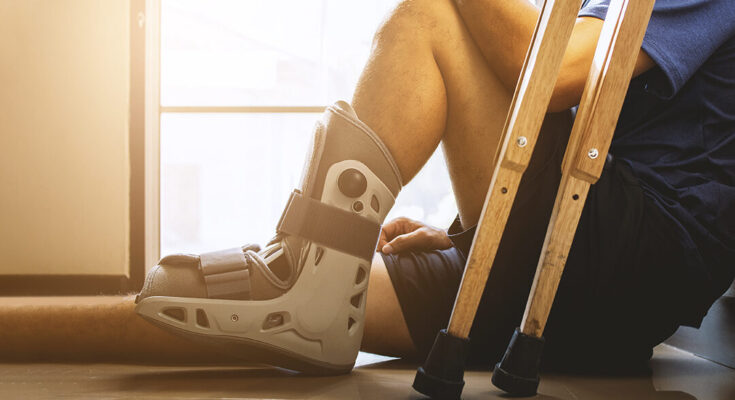Broken Foot Symptoms: A broken foot, medically known as a foot fracture, is a common injury that can significantly impact an individual’s mobility and overall quality of life.
Understanding the symptoms and causes of a broken foot is crucial for timely diagnosis and effective treatment.
What is a Broken Foot?
A broken foot is a medical condition that occurs when one or more bones in the foot fracture. This can result from various causes such as accidents, falls, sports injuries, or overuse. The foot, comprising 26 bones, is a complex structure vulnerable to fractures, particularly in the metatarsal bones and toes.
Statistics About Foot Injuries and Fractures
Understanding the prevalence and patterns of foot injuries is crucial for both preventative measures and effective treatments. Here are some key statistics:
- Incidence Rates: Foot fractures account for about 10% of all bone fractures. This percentage underscores the foot’s susceptibility to injury, given its crucial role in mobility and weight-bearing activities.
- Common Causes: Sports and physical activities are common culprits, with an estimated 25% of sports-related injuries involving the foot or ankle. Additionally, accidental falls, especially in older adults, contribute significantly to foot fractures.
- Age and Gender Factors: Foot fractures occur more frequently in certain age groups and genders. For instance, middle-aged and older adults are more prone to fractures due to osteoporosis, while younger individuals often sustain these injuries from high-impact activities.
- Recovery and Impact: The recovery time for a broken foot varies, typically ranging from 6 to 8 weeks for minor fractures, and longer for more severe cases. These injuries can significantly impact an individual’s mobility and quality of life during the healing process.
- Preventive Measures: Wearing appropriate footwear, especially during physical activities, and maintaining good bone health through diet and exercise are key preventive strategies.
Understanding these statistics helps in raising awareness about the risks and implications of foot injuries. It also underscores the importance of preventive measures and timely medical intervention for those experiencing symptoms of a broken foot.
Symptoms of a Broken Foot
Identifying the symptoms of a broken foot is crucial for prompt and effective treatment. Here’s a detailed list of common symptoms associated with a broken foot:
- Intense Pain: The most immediate and noticeable symptom is severe pain, which often intensifies during walking or when pressure is applied.
- Swelling: Look for noticeable swelling around the affected area.
- Bruising: Discoloration and bruising are common indicators of a fracture.
- Deformity: In severe cases, the foot may appear deformed or misshapen.
- Difficulty Walking: Experiencing extreme discomfort or inability to walk is a tell-tale sign.
- Tenderness: The fractured area may be tender to the touch.
- Numbness: A broken foot can sometimes lead to numbness or a tingling sensation.
Differentiating Between a Broken Foot and Other Injuries
It’s important to distinguish a broken foot from other foot injuries like sprains or strains. Here are some tips to help you differentiate:
- Severity of Pain: While sprains may also cause pain, a broken foot usually results in more severe and sharp pain.
- Hearing a Snap or Pop: Hearing a noise at the injury’s onset is more common in fractures.
- Inability to Bear Weight: If you can’t put any weight on the foot, it might be broken.
- Swelling and Bruising Pattern: Swelling and bruising from a fracture tend to be more localized and intense.
- Duration of Symptoms: If symptoms persist or worsen over a few days, it’s more likely to be a break than a sprain.
Always seek medical attention for an accurate diagnosis and treatment plan if you suspect a broken foot. Early intervention is key to a swift and effective recovery.
Causes of a Broken Foot
A broken foot, medically known as a foot fracture, can result from a variety of causes, ranging from accidental injuries to underlying medical conditions. Understanding these causes is essential for prevention and appropriate treatment.
Common Causes Leading to a Broken Foot
Traumatic Injury: The most prevalent cause of a broken foot is a traumatic injury. This can include incidents such as dropping a heavy object on your foot, falling, or experiencing a forceful impact during sports activities.
Overuse or Repetitive Motion: Stress fractures, a specific type of foot fracture, often occur due to overuse or repetitive motion. Runners and athletes participating in high-impact sports are particularly susceptible to this type of injury.
Weak Bones: Conditions like osteoporosis, which weaken the bones, significantly increase the risk of fractures, even from minor falls or stresses.
Improper Footwear: Wearing shoes that provide inadequate support or do not fit properly can lead to foot injuries, including fractures.
Accidents: Automobile accidents or falls from a significant height can cause severe foot injuries, including multiple fractures.
Discussion of Risk Factors
Several factors can increase an individual’s risk of sustaining a foot fracture:
- Age: Older adults are more prone to foot fractures, primarily due to weaker bones and a higher risk of falls.
- Activity Level: Engaging in high-impact sports without proper training or equipment increases the risk of foot injuries.
- Bone Health: Individuals with bone-weakening diseases such as osteoporosis are at a higher risk of foot fractures.
- Previous Foot Injuries: A history of foot injuries can weaken the foot structure, making it more susceptible to fractures.
By understanding these causes and risk factors, individuals can take proactive steps to protect their feet. This includes wearing appropriate footwear, engaging in exercises to strengthen the foot muscles, and managing underlying health conditions that may weaken the bones. Remember, if you suspect a broken foot, it is crucial to seek medical attention promptly for proper diagnosis and treatment.
Diagnosing a Broken Foot
Understanding the steps involved in diagnosing a broken foot is crucial for effective treatment and quick recovery. This article provides an in-depth look at the diagnostic process, highlighting the various tests and imaging techniques used by healthcare professionals.
Step-by-Step Diagnostic Process
Initial Assessment: The first step in diagnosing a broken foot is a thorough assessment by a medical professional. This typically involves discussing the patient’s symptoms, how the injury occurred, and any relevant medical history.
Physical Examination: A physical examination of the affected foot is conducted to check for signs of swelling, bruising, tenderness, and deformity. The doctor will also assess the range of motion and check for any open wounds.
Pain Evaluation: Understanding the location and intensity of pain helps in pinpointing the affected area. Patients are usually asked to describe their pain and indicate the area that feels most tender.
Types of Tests and Imaging
X-rays: X-rays are the most common imaging test for diagnosing broken bones, including foot fractures. They provide clear images of the bone structure, helping to identify the location and extent of the fracture.
CT Scans: In cases where X-ray results are inconclusive or if the injury involves complex bone structures, a CT (Computed Tomography) scan may be recommended. CT scans offer detailed cross-sectional images of the bones.
MRI: Magnetic Resonance Imaging (MRI) is used when there’s a need to evaluate soft tissues around the fracture or to assess injuries to ligaments and tendons.
Bone Scan: For detecting stress fractures that may not be visible on X-rays, a bone scan might be conducted. This involves injecting a small amount of radioactive material into the bloodstream, which accumulates in areas of bone growth or repair, highlighting the fracture.
Diagnosing a broken foot involves a combination of a thorough physical examination and various imaging tests. Understanding these steps can help patients gain insight into the diagnostic process and set realistic expectations for recovery. Early diagnosis and appropriate treatment are key to a successful recovery from a foot fracture.
Treatment Options for a Broken Foot
Here we outline the various treatment methods available and emphasize the importance of medical intervention and adherence to a prescribed treatment plan.
List of Treatment Methods
Rest: The cornerstone of treating a broken foot is giving it time to heal. Avoid putting weight on the injured foot as directed by your healthcare provider.
Ice: Applying ice to the injured area can help reduce swelling and pain. It’s advisable to ice the foot for 20 minutes several times a day during the initial days after the injury.
Compression: Using an elastic bandage or compression wrap can help minimize swelling and provide support to the injured foot.
Elevation: Elevating the foot above heart level, especially during the first few days, can significantly reduce swelling and pain.
Pain Relief Medication: Over-the-counter pain relievers like ibuprofen or acetaminophen can be used to manage pain. Always follow the dosage instructions or consult your doctor.
Casting or Splinting: To immobilize the foot and allow the bones to heal correctly, your doctor might recommend a cast or splint.
Physical Therapy: After the initial healing, physical therapy may be necessary to restore strength, flexibility, and function to the foot.
Surgery: In some cases, particularly when bones are misaligned or severely broken, surgery may be required to properly set the bones.
Importance of Medical Intervention and Following a Treatment Plan
Seeking prompt medical attention for a broken foot is vital. A healthcare professional can accurately diagnose the severity of the break and recommend the most appropriate treatment plan. Ignoring or delaying treatment can lead to complications like misaligned bones, delayed healing, or chronic pain.
Adhering to your treatment plan is just as crucial. Each step in the recovery process, from resting to physical therapy, plays a significant role in ensuring a full recovery. Following your doctor’s advice and attending all follow-up appointments is essential for monitoring your progress and making any necessary adjustments to your treatment.
Remember, while the Internet provides valuable information, it should never replace professional medical advice. If you suspect you have a broken foot, consult a healthcare provider immediately.
Preventing a Broken Foot: Essential Tips and Strategies
Let’s, explore effective tips and strategies to prevent foot injuries, emphasizing the critical role of footwear and lifestyle choices in keeping your feet healthy.
Tips for Preventing Foot Injuries
Choose the Right Footwear: Selecting the appropriate shoes is crucial in preventing foot injuries. Look for shoes that offer good support, have a comfortable fit, and are suitable for your activities. Avoid high heels and shoes with poor arch support as they can increase the risk of foot injuries.
Maintain a Healthy Weight: Excess weight can put unnecessary strain on your feet, leading to a higher risk of injuries. Maintaining a healthy weight through a balanced diet and regular exercise can help in reducing this risk.
Stay Active and Exercise Regularly: Regular exercise strengthens the muscles in your feet and legs, which can help in preventing injuries. Focus on exercises that improve balance and flexibility.
Warm-Up Before Exercise: Always take time to warm up before engaging in any physical activity. This increases blood flow to your muscles and reduces the risk of injuries.
Avoid Overuse: Listen to your body and avoid pushing it beyond its limits. Overuse of your feet, especially in high-impact activities, can lead to stress fractures and other injuries.
The Role of Footwear and Lifestyle in Prevention
Footwear: The right footwear not only provides comfort but also helps in preventing injuries. Shoes designed for specific activities like running, hiking, or sports offer additional support and cushioning that protect your feet.
Lifestyle Choices: Lifestyle plays a significant role in foot health. Smoking, for instance, can impair blood circulation, increasing the risk of foot injuries. Adequate rest, hydration, and a balanced diet are also crucial for maintaining strong and healthy feet.
Preventing a broken foot involves a combination of the right footwear, maintaining a healthy weight, regular exercise, and sensible lifestyle choices. By following these tips and strategies, you can significantly reduce your risk of foot injuries and maintain optimal foot health.
When to See a Doctor for a Broken Foot
Knowing when to seek medical attention for a suspected broken foot is crucial. In this section, we’ll provide clear guidance on recognizing severe symptoms and emphasize the importance of timely medical attention.
Recognizing Severe Symptoms
A broken foot can present a range of symptoms. However, certain signs indicate an urgent need for a doctor’s visit. These include:
- Intense Pain: If the pain is unbearable or significantly worsens when putting weight on the foot, it could be a fracture.
- Visible Deformity: Any noticeable deformity or misalignment in the foot structure should be considered serious.
- Swelling and Bruising: While some swelling is normal, excessive swelling or bruising, especially if it appears rapidly, is a red flag.
- Inability to Walk: Difficulty in walking or complete inability to bear weight on the foot is a strong indication of a break.
- Numbness or Tingling: These sensations, particularly if they increase or are accompanied by a decrease in foot temperature, could signal nerve or blood vessel damage.
Importance of Timely Medical Attention
Delaying a doctor’s visit for a broken foot can have severe consequences. Early diagnosis and treatment are vital for:
- Preventing Complications: Untreated breaks can lead to complications like misalignment, arthritis, and chronic pain.
- Ensuring Proper Healing: Prompt medical care ensures that the bone heals correctly and swiftly.
- Avoiding Long-Term Damage: Immediate attention can prevent long-term damage that might arise from a neglected fracture.
If you suspect a broken foot, particularly if you experience any of the severe symptoms listed above, it’s essential to seek medical attention immediately. Timely treatment not only alleviates pain but also plays a pivotal role in ensuring a full and rapid recovery.
FAQs About Broken Foot Symptoms and Causes
What Are the Common Symptoms of a Broken Foot?
Answer: The most typical symptoms of a broken foot include severe pain, swelling, bruising, tenderness, and difficulty walking or bearing weight on the foot. In some cases, the foot may appear deformed or exhibit an unusual angle.
Can You Walk on a Broken Foot?
Answer: It’s often possible to walk on a broken foot, especially if it’s a minor fracture. However, walking on a broken foot can exacerbate the injury and delay healing. It’s crucial to seek medical advice if you suspect a foot fracture.
What Causes Most Broken Feet?
Answer: Broken feet are commonly caused by direct impacts or trauma, such as dropping something heavy on the foot, or from a fall. Stress fractures, small cracks in the bone, can also occur from repeated stress or overuse.
How Can I Tell if My Foot Is Broken or Just Sprained?
Answer: While symptoms of a broken foot and a sprain can be similar, a break often causes more severe pain and noticeable deformity. An X-ray is the most definitive way to distinguish between a fracture and a sprain.
What Should I Do If I Think My Foot Is Broken?
Answer: If you suspect a broken foot, seek medical attention immediately. Until you can get to a healthcare provider, rest the foot, apply ice, compress with a bandage, and elevate it to reduce swelling.
How Long Does It Take for a Broken Foot to Heal?
Answer: The healing time for a broken foot varies depending on the severity of the break but typically takes 6 to 8 weeks. Proper treatment and avoiding putting weight on the foot can expedite healing.
Conclusion
While understanding these symptoms is beneficial, it’s imperative to remember that self-diagnosis is not a substitute for professional medical advice. Foot injuries, such as a break or fracture, require the expertise of a healthcare professional to diagnose and treat effectively. Ignoring or improperly treating a broken foot can lead to complications, prolonged pain, and even long-term damage.
Therefore, if you suspect a broken foot, or experience any of the symptoms mentioned above, we strongly encourage you to seek immediate medical attention. A healthcare provider will offer the best course of action, which may include x-rays, immobilization, or even surgery, depending on the severity of the injury. Early intervention is key to a swift and successful recovery.
In summary, stay vigilant about the symptoms of a broken foot and prioritize your health by consulting with a medical professional. Your feet are foundational to your daily life, and taking care of them is essential for maintaining your overall well-being and mobility



